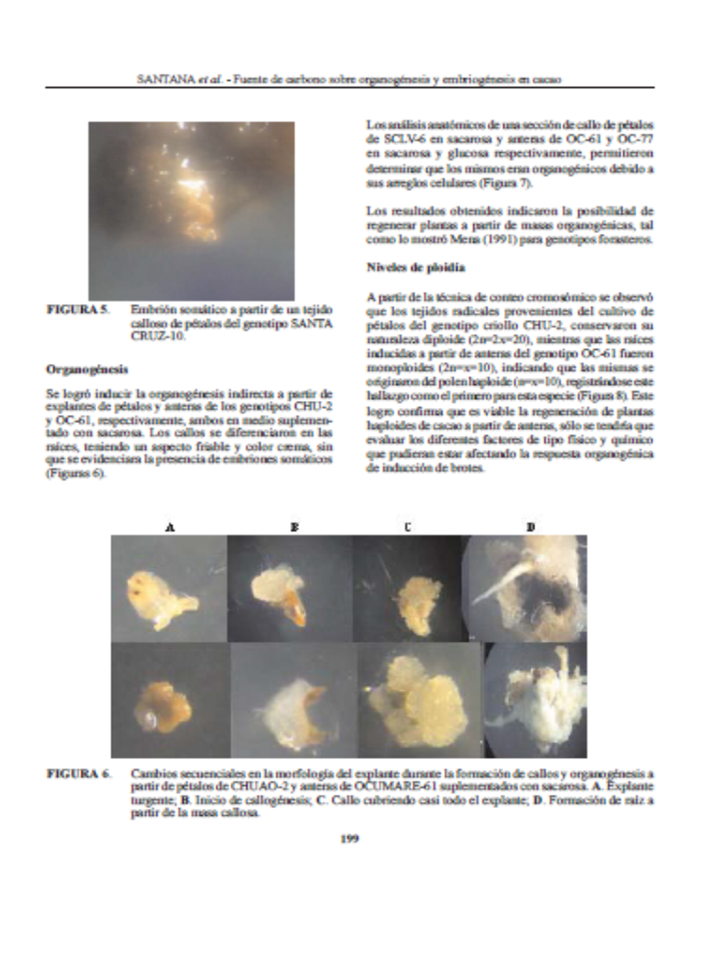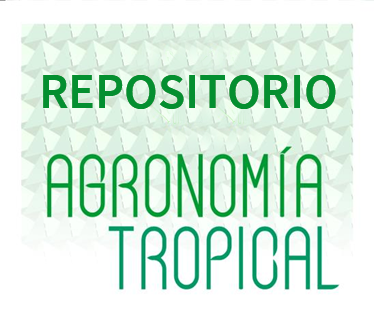Carbon source effect on cacao organogenesis and somatic embryogenesis. Citogenetic analysis
Abstract
The culture of anthers and petals in vitro has been used in this research in order to get a protocol to induce callus formation and somatic embryogenesis in seven venezuelan cacao, Theobroma cacao L., cultivars: OCUMARE-61, OCUMARE-67, CHORONÍ-42, GUASARE-133, CHUAO-2, SANTA CRUZ DE LA VEGA-6 and SANTA CRUZ-10, using DKW media and three different carbon sources: glucose, fructose and sucrose. The randomized design in a factorial arrangement 3x7 was used. Floral buds of 1.5 to 2 mm of length with microspores in tetrad stage were selected and treated at 12 °C for 48h. To callus and proembriogenic masses development, coconut water and aminoacids respectively was added in culture medium. The results of percentage of expanded explants, necrosis, callus induction and ploidy level were analyzed through Kruskal and Wallis test. In this research, callus formation was difficult for both explants and responses varies with cultivars and carbon source. Histological analysis allowed to establish the formation of organogenic callus in some cultivars, but only OCUMARE-61 anthers and CHUAO-2 petioles growing in media supplemented with sucrose, root formation was observed. Somatic embryogenesis was formed from SANTA CRUZ-10 petioles with glucose. The chromosomal analysis of roots revealed haploid number (2n=X=10), indicating the viability to obtain haploid cocoa plants through the anther culture technique, so it is important to study the effect of the physical and chemical factors may have under the induction of shoots and roots of cocoa somatic embryos
Downloads
References
• Ascanio, C. 1999. Suspensiones celulares en café (Coffea arabica L. ‘Catuaí´) y su aplicación en la obtención de somaclones resistentes al filtrado tóxico de Colletotrichum gloeosporioides. Trabajo de ascenso. Maracay, Ven. Universidad Central de Venezuela. Facultad de Agronomía. 79 p.
• Ascanio, C. y A. Arcia. 1994. Efecto del estado de desarrollo de las anteras y de un ´shock´ térmico sobre la androgénesis en Coffea arabica L. Var. Garnica. Maracay, Venezuela. Café cacao Thé. 38(2):75-80.
• Chanatásig, C. 2004. Inducción de embriogénesis somática en clones superiores de cacao (Theobroma cacao L.), con resistencia a enfermedades fungosas. Tesis Mag. Sc. CATIE. Costa Rica. 87 p.
• Driver, D. and A. Kuniyuki. 1984. In vitro propagation of Paradox Walnut Rootstock. Hortscience 19: 507-509.
• González, M., M. Hernández, L. Mazorra, N. Santana, Y. Rodríguez y M. Cabrera. 2005. Influencia de la época del año en la respuesta in vitro del cafeto Coffea canephora P. Var. Robusta. Revista Colombiana de Biotecnología. 7(1):5-14.
• Graziani, L. 2000. Calidad del cacao. In: Memorias del Primer Congreso Venezolano del Cacao y su Industria. Caracas, Venezuela. 198-199 pp.
• Lentini, Z., C. Martínez y W. Roca. 1997. Cultivo de anteras de arroz en el desarrollo de germoplasma. Centro Internacional de Agricultura Tropical CIAT. Cali, Colombia. 57 p.
• Litz, R. y R. Jarret. 1991. Regeneración de plantas en el cultivo de tejidos: embriogénesis somática y organogénesis. In: M. W. Roca y L. A. Mroginski. Cultivo de tejidos en la agricultura. CIAT. Cali, Colombia.144-161 pp.
• López-Báez, O., J. Moreno y S. Pacheco. 2000. Avances en Propagación de cacao Theobroma cacao L. por embriogénesis somática en México (en línea). Disponible en: https://bit.ly/2UNIod3
• Maximova, S., A. Young, S. Pishak, C. Miller, A. Traore and M. Guiltinan. 2005. Integrated system for propagation of Theobroma cacao L. In: Protocol for somatic embryogenesis in woody plants. S.M. Jain and P.K. Gupta, Eds. The Netherlands, Springer. 209-229 pp.
• Maximova, S., L. Alemanno, A. Young, N. Ferriere, A. Traore and M. Guiltinan. 2002. Efficiency, Genotypic variability and cellular origin of primary and secondary somatic embryogenesis of Theobroma cacao L., in Vitro Cell. Dev. Biol. Plant. 38:252–259.
• Mena, S. 1991. Estudios del comportamiento de anteras de cacao (Theobroma cacao L.) en cultivo in vitro. Tesis Mag. Sc. CATIE. Costa Rica. 124 p.
• Michelangeli, C., P. Artioli y A. Medina. 2003. Anatomía y ultraestructura de la embriogénesis somática en Onoto (Bixa orellana L.). Agro. Trop. 53(1):33-48.
• Pinto, J. 1997. Calidad y certificación del cacao venezolano. In: I congreso venezolano del cacao y su industria. Caracas, Venezuela. 189-197 pp.
• Rondón, J.; Cumana, L. 2005. Revisión taxonómica del género Theobroma (Sterculiaceae) en Venezuela. Acta Bot. Venez. 28(1): 113-133.
• Santana, G., R. Velásquez y M. Chirinos. 2007. Efecto del tamaño del botón floral y ´shock´ térmico sobre la androgénesis del cacao (Theobroma cacao L.). In: VI Encuentro latinoamericano y del Caribe de Biotecnología Agrícola REDBIO 2007. Viña del Mar, Chile. Poster 444.
• Teixeira, J., P. Santos e M. Oliveira. 2002. Otimização da metodologia de embriogênese somática visando a propagação clonal de genótipos elite de cacau (Theobroma cacao L.). Embrapa Recursos Genéticos e Biotecnología. Brasília. Documento técnico nº 79. Brasil. 34 p.
• Traore, A. and M. Guiltinan. 2006. Effects of carbon source and explant type on somatic embryogenesis of four cacao genotypes. Hortscience. 41:753-758.
• Trejo, G., U. Maldonado, A. Jiménez, M. Blanqueto, G. Salcedo, B. Martínez y A. Sánchez. 2002. Efecto del tiempo de exposición a baja temperatura y de reguladores de crecimiento en la regeneración de plantas a partir de anteras de arroz Oryza sativa L. (Cultivar Japónica H2005). México. Agrociencia. 36(4):441-449.
• Velásquez, R. 2005. Embriogénesis somática en diferentes clones de cacao (Theobroma cacao L.). Trabajo de ascenso. Maracay, Ven. Universidad Central de Venezuela. 49 p.
• Velásquez, R. Y. Sandrea, C. Betancourt, J. Mata y F. García. 2006. Embriogénesis somática en cultivares de cacao (Theobroma cacao L.) venezolano. Agronomía Trop. 56(1):61-74.
• Whitlock, B. A., C. Bayer, D. A. Baum. 2001. Phylogenetic relationships and floral evolution of the Byttnerioideae (“Sterculiacaea” or Malvaceae s.l.) based on sequences of the chloroplast gene, ndhF. John V.; Freudenstein Editeur. System. Bot. 26(2):420-437.





